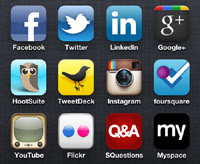 |
| Image: Social Media HQ on Flickr. |
1) Visit your web site from your mobile device, and your friends' mobile devices. Do you have to do a lot of zooming in and out? Are the links too small to click? Is data that might be critical for mobile users (like your location and hours) easy to find? What's the difference between the phone and tablet experience?
This is called "responsive design" and even though your budget's stretched, it's critical that your site can respond to whatever device is using it. Otherwise, you may be turning your audience away at the door. Decide which elements aren't working for mobile users of your web site, and then invest in a web designer who can fix this for you. Make sure to find a specialist in responsive design. You'll want to incorporate easy clicking, quick loading, and simple navigation.
2) Don't just visit your web site, try buying something, making a donation, signing up for email, account login, and any other transactional functions from your phone and tablet. Note what's kludgey and what works well. Have your responsive design pro fix the kludgey parts. Does your purchase process take three or four screens? This is too many anyway - now's a good time to reduce that to one screen, no matter what device folks are using.
3) Figure out what mobile apps already exist that can help you. Are you on Facebook and Twitter, where lots of people surf while on their mobile devices? Are you on Yelp and other local review sites? Have you thought about selling your products on Amazon or other shopping sites? Can people check into your store on apps like Foursquare? If you're a non-profit, have you investigated Facebook Causes or worked with mobile providers to make text donations easy?
4) Then, and only then, consider whether or not you need to go the expense of having someone develop a mobile app for you. What will you do with it? How will it support lead generation, sales, or donations? On which devices will it be available? How will it leverage your brand? You may not even need a mobile app. Making your web site mobile-friendly is far, far more important.
Is mobile marketing giving you hives? Share your angst in the comments.
